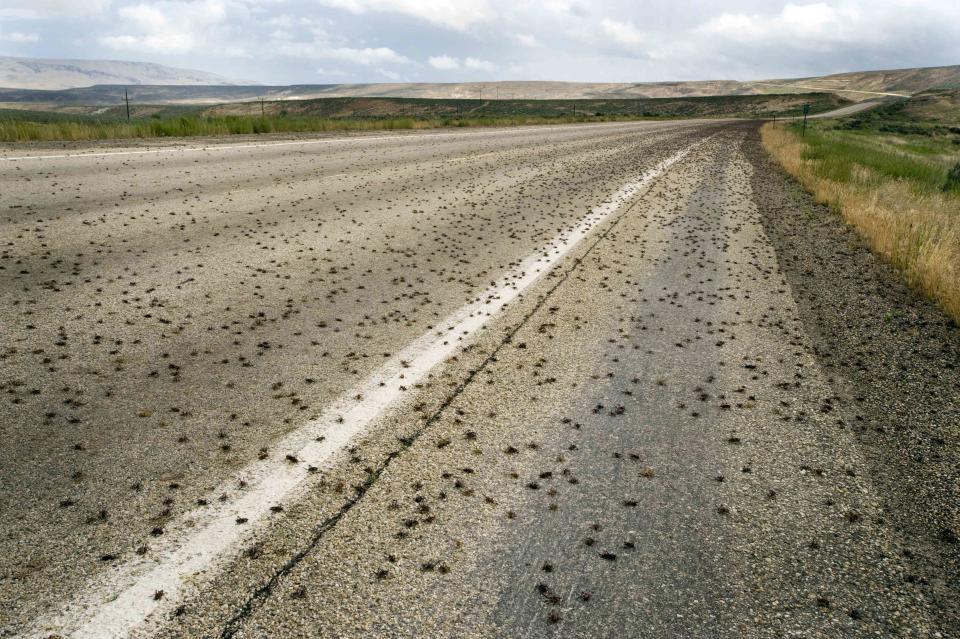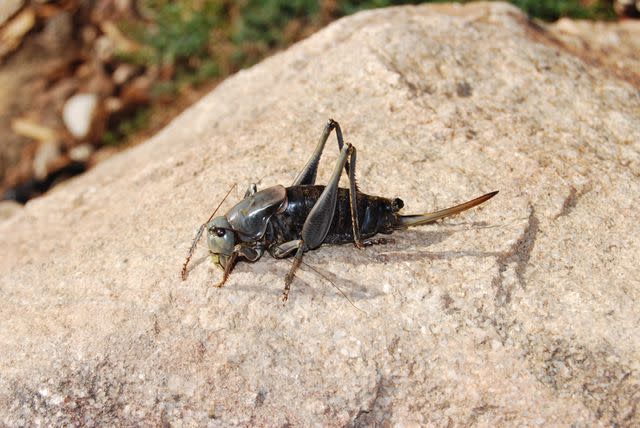Mormon Crickets Swarming the West Cause Traffic Hazards and Overall Chaos
An invasion of tens of thousands of these pests are distressing towns—and likely won't be going anywhere soon.

Across the West, apocalyptic-like hordes of Mormon crickets are swarming towns—causing traffic hazards, emitting a horrible stench, and making people's skin crawl. According to reporting by the Associated Press, tens of thousands of Mormon cricket eggs began to hatch in late May and early June, and for weeks, they have been intensely invading northern Nevada—and bringing mayhem with them.
Thousands are blanketing roads at a time, resulting in slippery driving conditions when squished by car tires. They've gotten so severe in some areas that the Nevada Department of Transportation have begun to use snowplows to rid the highways and streets of the slimy remains, warning drivers on Twitter to beware of conditions. In addition to their disagreeable viscosity, Mormon crickets can wreak havoc on crops and contribute to soil erosion, and their crushed ruins smell awful.
Related: Try These Garden Pest Control Methods to Protect Your Plants
"The United States Department of Agriculture monitors both grasshoppers and crickets throughout rangeland habitats in the western United States every year to alert farmers and cities of upcoming hazards," says Dr. Tracy Ellis, PhD, an entomologist at agricultural insect monitoring company FarmSense. "Counts at rangeland locations in Utah, Arizona, Colorado, and Idaho indicate grasshoppers will exceed three grasshoppers per square yard, particularly in Utah and Idaho this year. The USDA predicts high populations of Mormon crickets in localized pockets in Montana, Nevada, Wyoming, Colorado, Utah, but particularly northern Nevada and southern Idaho."

SuZanBare / Getty Images
Mormon crickets are unsightly, large (they can grow to be 2 inches long or more), and understandably make most people squeamish. Kimmy Hall, manager at the Shilo Inn in Elko, Nevada, told the New York Times that after trying many methods to get rid of the giant insects, she told her staff, “We can’t win against them. But we can hold them off.” The bugs crawl up the sides of buildings in large numbers, creating a frightening brick-red mass, and they're known to crawl into homes and backpacks.
Last year in Oregon, the Mormon cricket problem warranted a $5 million allocation into investigating how to stop invasions, and another $1.2 million was authorized earlier this month. In some parts of the state, goats and chickens were introduced as predators of the bugs—it helped slightly, but not enough. The most effective control method found thus far is aerial spraying of diflubenzuron (which environmental groups generally oppose).
Related: What Are Leafhoppers and How to Get Rid of These Pests
Fun fact: Mormon crickets aren’t actually crickets. They’re a type of katydid with a hard shieldback, and the males make a chirping sound reminiscent of a cricket. They got their name in Utah in the mid-1800s, when they repeatedly invaded the crops of Mormon settlers.
These critters won't be going anywhere for the next few weeks, unfortunately—male crickets die after they mate, female crickets after laying their eggs. Until then, the plows will likely have to stay close.
For more Better Homes & Gardens news, make sure to sign up for our newsletter!
Read the original article on Better Homes & Gardens.

